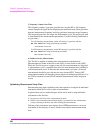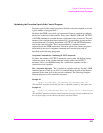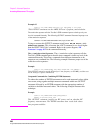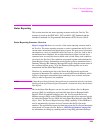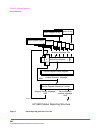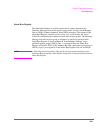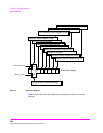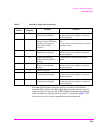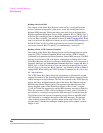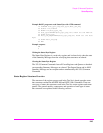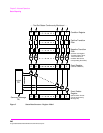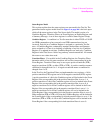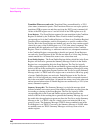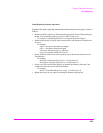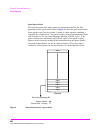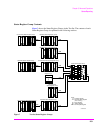
244
S:\agilent\8920\8920b\PRGGUIDE\BOOK\CHAPTERS\advoper.fb
Chapter 5, Advanced Operations
Status Reporting
Reading with a Serial Poll
The contents of the Status Byte Register can be read by a serial poll from the
Active Controller in response to some device on the bus sending the Service
Request (SRQ) message. When read with a serial poll, bit 6 in the Status Byte
Register represents the Request Service (RQS) condition. Bit 6 is TRUE, logic 1,
if the Test Set is sending the Service Request (SRQ) message and FALSE, logic 0,
if it is not. Bits 0-5 and bit 7 are defined as shown in
Table 17 on page 5 243. When
read by a serial poll the RQS bit is cleared (set to 0) so that the RQS message will
be FALSE if the Test Set is polled again before a new reason for requesting
service has occurred. Bits 0-5 and bit 7 are unaffected by a serial poll.
Reading with the *STB? Common Command
The contents of the Status Byte Register can be read by the application program
using the *STB? Common Command. When read with the *STB? Common
Command, bit 6 represents the Master Summary Status (MSS) message. The MSS
message is the inclusive OR of the bitwise combination (excluding bit 6) of the
Status Byte Register and the Service Request Enable Register. For a discussion of
Summary Messages, see
“Status Register Structure Overview” on page 245. Bit 6 is
TRUE, logic 1, if the Test Set has at least one reason for requesting service and
FALSE, logic 0, if it does not. Bits 0-5 and bit 7 are defined as shown in
Table 17
on page 5 243
. When read by the *STB? Common Command, bits 0-5, bit 6, and
bit 7 are unaffected
The *STB? Status Byte Query allows the programmer to determine the current
contents (bit pattern) of the Status Byte Register and the Master Summary Status
(MSS) message as a single element. The Test Set responds to the *STB? query by
placing the binary-weighted decimal value of the Status Byte Register and the
MSS message into the Output Queue. The response represents the sum of the
binary-weighted values of the Status Byte Register’s bits 0-5 and 7 (weights
1,2,4,8,16,32 and 128 respectively) and the MSS summary message (weight 64).
Thus, the response to *STB?, when considered as a binary value, is identical to
the response to a serial poll except that the MSS message of
1 indicates that the
Test Set has at least one reason for requesting service (Refer to the IEEE 488.2-
1987 Standard for a complete description of the MSS message). The decimal
value of the bit pattern will be a positive integer in the range of 0 to 255. The
response data is obtained by reading the Output Queue into a numeric variable,
integer or real.



